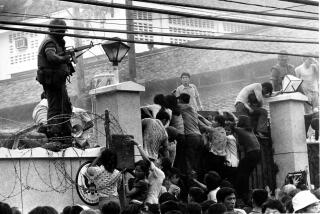Long, Rocky Road to Cooperation
- Share via
Key events in the history of U.S. military involvement in Vietnam (1954-1975) and highlights of America’s postwar involvement (1975-1994):
1954-1975
* 1954: After the defeat of French Expeditionary Forces at Dien Bien Phu, France recognizes independence of Vietnam. It agrees to withdraw military forces immediately from the area that became North Vietnam, and by 1956 from South Vietnam.
* 1956: With support of the United States, Ngo Dinh Diem is installed in Saigon as president of an independent Republic of Vietnam, setting up the rival claims to legitimacy that led to the Vietnamese civil war.
* 1961: President John F. Kennedy decides to ignore the limits on foreign military advisers imposed by Geneva Accords of 1954, and begins buildup of American forces in South Vietnam.
* 1964: Armed with Tonkin Gulf resolution, which gave him a free hand to protect U.S. forces, President Lyndon B. Johnson launches first strikes of the air war against North Vietnam, and imposes an embargo on Hanoi.
* 1965: U.S. sends first organized combat units to Vietnam, beginning with U.S. Marines landing in Central Vietnam.
* 1968: Viet Cong launch Tet offensive, attacking more than 100 cities in the south, and undermining Gen. William C. Westmoreland’s claims that Communists had been put on the defensive. President Johnson decides not to seek reelection; Richard M. Nixon is elected after claiming he had a “secret plan” to end the war.
* 1969: Peace negotiators, representing the United States and three Vietnamese factions, open Paris peace talks.
* 1970: Domestic opposition to the war crests, partly in reaction to National Guardsmen shooting to death four students at Kent State University during an anti-war protest demonstration.
* 1973: United States signs peace agreement, which calls for withdrawal of U.S. military from the South, and the release of prisoners of war.
* 1975: Vietnamese Communist forces capture Saigon and the remainder of the country, triggering an exodus of South Vietnamese refugees, who continued fleeing the country for years.
1975-1994
* 1975: First wave of Vietnamese refugees begin arriving in the United States, the first planeloads going to Eglin Air Force Base in Florida. The second wave, the so-called boat people, who continued to flee the Communists by every means imaginable, began arriving in the United States the next year. The largest single Vietnamese community takes root in Orange County, and an area of Westminster becomes known as Little Saigon.
* 1977: Washington begins normalization talks with Hanoi, but breaks them off when Vietnam invades neighboring Cambodia.
* 1988: Vietnam begins cooperating with the United States to help determine the fate of more than 2,000 U.S. troops still missing and unaccounted for at the time.
* 1989: Vietnam completes its withdrawal from Cambodia, fulfilling a condition for improved relations with the United States and some European nations.
* 1990: In a sign of further relaxation, Vietnam’s foreign minister Nguyen Co Thach makes an unprecedented visit to Washington, pledges to do everything possible to resolve the issue of MIAs in Vietnam.
* 1991: Hanoi and Washington agree to opening of a U.S. government office in Hanoi to settle issue of missing American troops. By December, Washington lifts ban on organized U.S. travel to Vietnam.
* 1992: President Bush allows U.S. companies to open offices in Vietnam to position themselves for lifting of the trade embargo.
* 1993: President Clinton announces that United States would no longer block an International Monetary Fund loan package to Vietnam. He eases sanctions to allow U.S. firms to participate in international development projects.
* January, 1994: Senate passes non-binding resolution calling on Clinton to lift the embargo.
* Feb. 3, 1994: Clinton lifts trade embargo.
Source: Los Angeles Times
More to Read
Sign up for Essential California
The most important California stories and recommendations in your inbox every morning.
You may occasionally receive promotional content from the Los Angeles Times.










